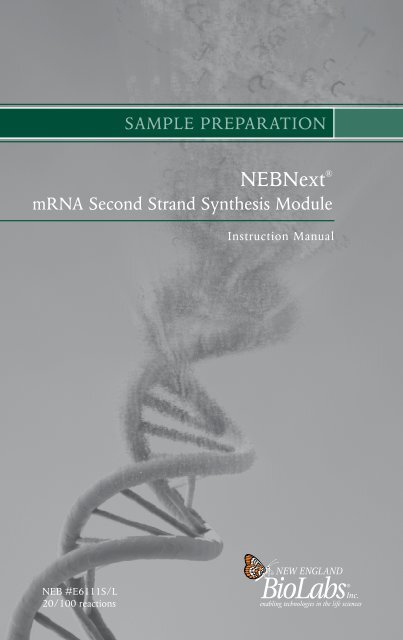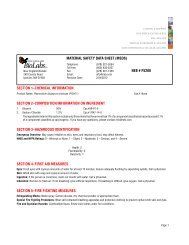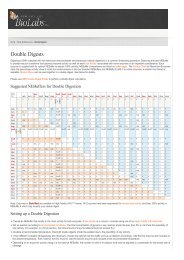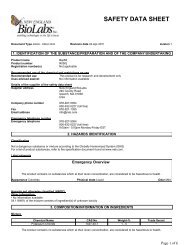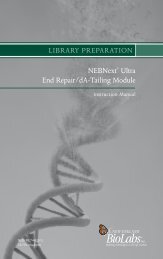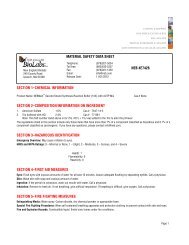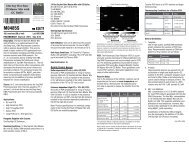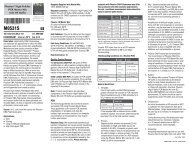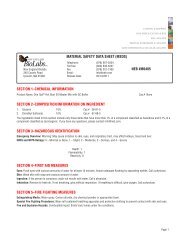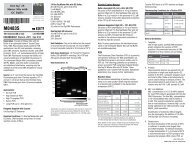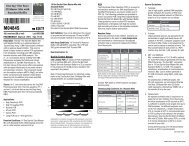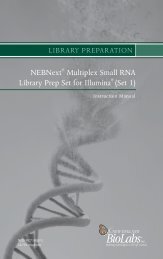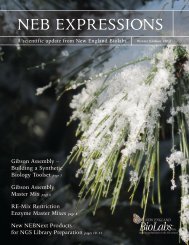manual NEBNext mRNA Second Strand Synthesis Module E6111S ...
manual NEBNext mRNA Second Strand Synthesis Module E6111S ...
manual NEBNext mRNA Second Strand Synthesis Module E6111S ...
You also want an ePaper? Increase the reach of your titles
YUMPU automatically turns print PDFs into web optimized ePapers that Google loves.
SAMPLE PREPARATION<br />
<strong>NEBNext</strong> ®<br />
<strong>mRNA</strong> <strong>Second</strong> <strong>Strand</strong> <strong>Synthesis</strong> <strong>Module</strong><br />
NEB #<strong>E6111S</strong>/L<br />
20/100 reactions<br />
Instruction Manual
<strong>NEBNext</strong> ®<br />
<strong>mRNA</strong> <strong>Second</strong> <strong>Strand</strong> <strong>Synthesis</strong> <strong>Module</strong><br />
Table of Contents:<br />
Description . . . . . . . . . . . . . . . . . . . . . . . . . . . . . . . . . . . . . . . . . . . . . . . . . . . . . . . . . . . . . . . . . . . . . . . . . . . . .2<br />
Applications . . . . . . . . . . . . . . . . . . . . . . . . . . . . . . . . . . . . . . . . . . . . . . . . . . . . . . . . . . . . . . . . . . . . . . . . . . . .2<br />
Advantages . . . . . . . . . . . . . . . . . . . . . . . . . . . . . . . . . . . . . . . . . . . . . . . . . . . . . . . . . . . . . . . . . . . . . . . . . . . .2<br />
Protocol . . . . . . . . . . . . . . . . . . . . . . . . . . . . . . . . . . . . . . . . . . . . . . . . . . . . . . . . . . . . . . . . . . . . . . . . . . . . . . . .3<br />
<strong>NEBNext</strong> <strong>Second</strong> <strong>Strand</strong> <strong>Synthesis</strong> Enzyme Mix . . . . . . . . . . . . . . . . . . . . . . . . . . . . . . . . . .4<br />
<strong>NEBNext</strong> <strong>Second</strong> <strong>Strand</strong> <strong>Synthesis</strong> Reaction Buffer . . . . . . . . . . . . . . . . . . . . . . . . . . . . . .5<br />
The <strong>Module</strong> Includes:<br />
The volumes provided are sufficient for preparation of up to 20 reactions<br />
(NEB #<strong>E6111S</strong>) and 100 reactions (NEB #E6111L). (All reagents should be<br />
stored at –20°C).<br />
<strong>NEBNext</strong> <strong>Second</strong> <strong>Strand</strong> <strong>Synthesis</strong> Enzyme Mix<br />
<strong>NEBNext</strong> <strong>Second</strong> <strong>Strand</strong> <strong>Synthesis</strong> Reaction Buffer (10X)<br />
1
2<br />
Description:<br />
The <strong>NEBNext</strong> ®<br />
<strong>Second</strong> <strong>Strand</strong> <strong>Synthesis</strong> <strong>Module</strong> has been optimized to<br />
generate double stranded cDNA from first strand cDNA . The <strong>NEBNext</strong> <strong>Second</strong><br />
<strong>Strand</strong> <strong>Synthesis</strong> <strong>Module</strong> is provided as a master mix to maximize efficiency<br />
and convenience in RNA sample preparation workflows .<br />
The dsDNA generated by the <strong>NEBNext</strong> <strong>Second</strong> <strong>Strand</strong> <strong>Synthesis</strong> <strong>Module</strong> can<br />
be subsequently converted to blunt ended DNA fragments using the <strong>NEBNext</strong><br />
End Repair <strong>Module</strong> .<br />
The <strong>NEBNext</strong> <strong>Second</strong> <strong>Strand</strong> <strong>Synthesis</strong> <strong>Module</strong> has been validated by<br />
sequencing with the Illumina ® GAIIx in conjunction with SuperScript ® II<br />
Reverse Transcriptase, <strong>NEBNext</strong> First <strong>Strand</strong> <strong>Synthesis</strong> Reaction Buffer,<br />
Murine RNase Inhibitor, the <strong>NEBNext</strong> End Repair Enzyme <strong>Module</strong>, the<br />
<strong>NEBNext</strong> dA-Tailing <strong>Module</strong>, the <strong>NEBNext</strong> Quick Ligation <strong>Module</strong>, Phusion ®<br />
DNA Polymerase, and Phusion HF Buffer .<br />
For larger volume requirements, customized and bulk packaging is available<br />
by purchasing through the OEM/Bulks department at NEB . Please contact<br />
OEM@neb .com for further information .<br />
Applications:<br />
RNA Sample Preparation<br />
<strong>Second</strong> <strong>Strand</strong> <strong>Synthesis</strong> of cDNA<br />
Advantages:<br />
• Efficient – Converts 10–100 ng of first strand cDNA into double stranded<br />
cDNA<br />
• Convenient – Reactions are provided in master mix format to reduce steps<br />
during RNA sample prep workflows<br />
• Automation Friendly<br />
SuperScript ® Phusion<br />
is a registered trademark of Invitrogen Corporation .<br />
® is a registered trademark of Finnzymes Oy, a Thermo Fisher Scientific company .<br />
Illumina ® is a registered trademark of Illumina, Inc .
Protocol:<br />
Starting Material: Heat inactivated first strand synthesis reaction containing<br />
10-100 ng of first strand cDNA in a 20 µl reaction volume .<br />
<strong>Second</strong> <strong>Strand</strong> cDNA <strong>Synthesis</strong><br />
1 . Place heat inactivated cDNA reaction on ice .<br />
2 . Add 48 µl Nuclease-Free Water to the reaction .<br />
3 . To the reaction add the following:<br />
10X <strong>Second</strong> <strong>Strand</strong> <strong>Synthesis</strong> Reaction Buffer 8 µl<br />
<strong>Second</strong> <strong>Strand</strong> <strong>Synthesis</strong> Enzyme Mix 4 µl<br />
Total volume 80 µl<br />
4 . Mix thoroughly by gentle pipetting .<br />
5 . Incubate in a thermal cycler for 2 .5 hours at 16°C .<br />
6 . Purify cDNA using a PCR column purification kit, purifying the sample on<br />
one column and eluting in sterile water or elution buffer .<br />
3
4<br />
<strong>NEBNext</strong> ®<br />
#E6112A: 80 µl<br />
#E6112AA: 400 µl<br />
Store at –20°C<br />
<strong>Second</strong> <strong>Strand</strong> <strong>Synthesis</strong> Enzyme Mix<br />
Description: <strong>NEBNext</strong> <strong>Second</strong> <strong>Strand</strong> <strong>Synthesis</strong> Enzyme Mix is optimized to<br />
conver 10–100 ng of short first strand cDNAs to double-stranded cDNAs with<br />
Random Primers and <strong>NEBNext</strong> <strong>Second</strong> <strong>Strand</strong> <strong>Synthesis</strong> Reaction Buffer .<br />
<strong>NEBNext</strong> <strong>Second</strong> <strong>Strand</strong> <strong>Synthesis</strong> Enzyme Mix:<br />
6,000 units/ml DNA Polymerase I (E. coli)<br />
5,000 units/ml RNase H<br />
25,000 units/ml E. coli DNA Ligase<br />
Supplied in: 10 mM Tris-HCl (pH 7 .5 @ 25°C), 50 mM KCl, 1 mM DTT,<br />
0 .1 mM EDTA and 50% glycerol .<br />
Quality Control Assays<br />
SDS-PAGE Purity: SDS-PAGE analysis of this enzyme indicates > 95% enzyme<br />
purity .<br />
Endonuclease Activity: Incubation of a 10 µl reaction containing 1 µl <strong>Second</strong><br />
<strong>Strand</strong> <strong>Synthesis</strong> Enzyme Mix with 300 ng supercoiled plasmid for 4 hours at<br />
37°C produced no nicked molecules as determined by gel electrophoresis .<br />
Phosphatase Activity: Incubation of a minimum of 1 µl <strong>Second</strong> <strong>Strand</strong> <strong>Synthesis</strong><br />
Enzyme Mix in protein phosphatase assay buffer (1 M diethanolamine<br />
@ pH 9 .8 and 0 .5 mM MgCl 2 ) containing 2 .5 mM p-nitrophenyl phosphate at<br />
37°C for 4 hours yields no detectable p-nitrophenylene anion as determined by<br />
spectrophotometric analysis at 405 nm .<br />
Functional Activity: One unit of the E. coli DNA Ligase ligated 50% of HindIII<br />
fragments of λ DNA (5´ DNA termini concentration of 0 .12 µM, 300 µg/ml) in<br />
a total reaction volume of 20 µl in 30 minutes at 16°C in 1X E. coli DNA Ligase<br />
Reaction Buffer . One unit of E. coli DNA Polymerase I incorporated 10 nmol<br />
of dNTP into acid-insoluble material in a total reaction volume of 50 µl in 30<br />
minutes at 37°C in 1X EcoPol Reaction Buffer with 33 µM dNTPs including<br />
[ 3 H]-dTTP and 70 µg/ml denatured herring sperm DNA . Incubation of 50 units<br />
of RNase H with 1 µg sonicated and denatured [ 3 H]-DNA (10 5 cpm/µg) for 30<br />
minutes at 37°C in 50 µl reaction buffer released < 0 .1% radioactivity .<br />
Lot Controlled
<strong>NEBNext</strong> ®<br />
<strong>Second</strong> <strong>Strand</strong> <strong>Synthesis</strong> Reaction Buffer<br />
#E6113A: 160 µl Concentration: 10X<br />
#E6113AA: 800 µl<br />
Store at –20°C<br />
1X <strong>NEBNext</strong> <strong>Second</strong> <strong>Strand</strong> <strong>Synthesis</strong> Reaction Buffer:<br />
20 mM Tris-HCl<br />
12 mM (NH 4 ) 2 SO 4<br />
5 mM MgCl 2<br />
0 .16 mM β-NAD<br />
0 .19 mM dNTPs each<br />
pH 7 .4 @ 25°C<br />
Quality Control Assays<br />
16-Hour Incubation: 50 µl reactions containing 1X <strong>NEBNext</strong> <strong>Second</strong> <strong>Strand</strong><br />
<strong>Synthesis</strong> Reaction Buffer and 1 µg of HindIII digested φX174 RF I DNA<br />
incubated for 16 hours at 37°C results in no detectable non-specific nuclease<br />
degradation as determined by agarose gel electrophoresis . 50 µl reactions<br />
containing 1X <strong>Second</strong> <strong>Strand</strong> <strong>Synthesis</strong> Reaction Buffer and 1 µg of T3 DNA<br />
incubated for 16 hours at 37°C results in no detectable non-specific nuclease<br />
degradation as determined by agarose gel electrophoresis .<br />
Endonuclease Activity: Incubation of a 10 µl reaction containing 1X <strong>NEBNext</strong><br />
<strong>Second</strong> <strong>Strand</strong> <strong>Synthesis</strong> Reaction Buffer with 300 ng supercoiled plasmid<br />
for 4 hours at 37°C produced no nicked molecules as determined by gel<br />
electrophoresis .<br />
RNase Activity: Incubation of a 10 µl reaction containing 1X <strong>NEBNext</strong> <strong>Second</strong><br />
<strong>Strand</strong> <strong>Synthesis</strong> Reaction Buffer with 40 ng of RNA transcript for 16 hours<br />
at 37°C resulted in no detectable degradation of RNA as determined by gel<br />
electrophoresis .<br />
Phosphatase Activity: Incubation of 1X <strong>NEBNext</strong> <strong>Second</strong> <strong>Strand</strong> <strong>Synthesis</strong><br />
Reaction Buffer in protein phosphatase assay buffer (1 M diethanolamine @<br />
pH 9 .8 and 0 .5 mM MgCl 2 ) containing 2 .5 mM p-nitrophenyl phosphate at<br />
37°C for 4 hours yields no detectable p-nitrophenylene anion as determined by<br />
spectrophotometric analysis at 405 nm .<br />
Lot Controlled<br />
5
USA<br />
New England Biolabs, Inc.<br />
240 County Road<br />
Ipswich, MA 01938-2723<br />
Telephone: (978) 927-5054<br />
Toll Free: (USA Orders) 1-800-632-5227<br />
Toll Free: (USA Tech) 1-800-632-7799<br />
Fax: (978) 921-1350<br />
e-mail: info@neb.com<br />
www.neb.com<br />
Canada<br />
New England Biolabs, Ltd.<br />
Telephone: (905) 837-2234<br />
Toll Free: 1-800-387-1095<br />
Fax: (905) 837-2994<br />
Fax Toll Free: 1-800-563-3789<br />
e-mail: info@ca.neb.com<br />
China, People’s Republic<br />
New England Biolabs (Beijing), Ltd.<br />
Telephone: 010-82378265/82378266<br />
Fax: 010-82378262<br />
e-mail: info@neb-china.com<br />
DNA CloNiNg<br />
DNA AmplifiCAtioN & pCR<br />
EpigENEtiCs<br />
RNA ANAlysis<br />
sAmplE pREp foR NExt gEN sEquENCiNg<br />
pRotEiN ExpREssioN & ANAlysis<br />
CEllulAR ANAlysis<br />
France<br />
New England Biolabs France<br />
Free Call: 0800/100 632<br />
Free Fax: 0800/100 610<br />
e-mail: info@fr.neb.com<br />
Germany<br />
New England Biolabs GmbH<br />
Telephone: +49/(0)69/305 23140<br />
Free Call: 0800/246 5227 (Germany)<br />
Fax +49/(0)69/305 23149<br />
Free Fax: 0800/246 5229 (Germany)<br />
e-mail: info@de.neb.com<br />
Japan<br />
New England Biolabs Japan, Inc.<br />
Telephone: +81 (0)3 5669 6191<br />
Fax +81 (0)3 5669 6192<br />
e-mail: info@neb-japan.com<br />
United Kingdom<br />
New England Biolabs (UK), Ltd.<br />
Telephone: (01462) 420616<br />
Call Free: 0800 318486<br />
Fax: (01462) 421057<br />
Fax Free: 0800 435682<br />
e-mail: info@uk.neb.com<br />
Version 1.0<br />
9/10


